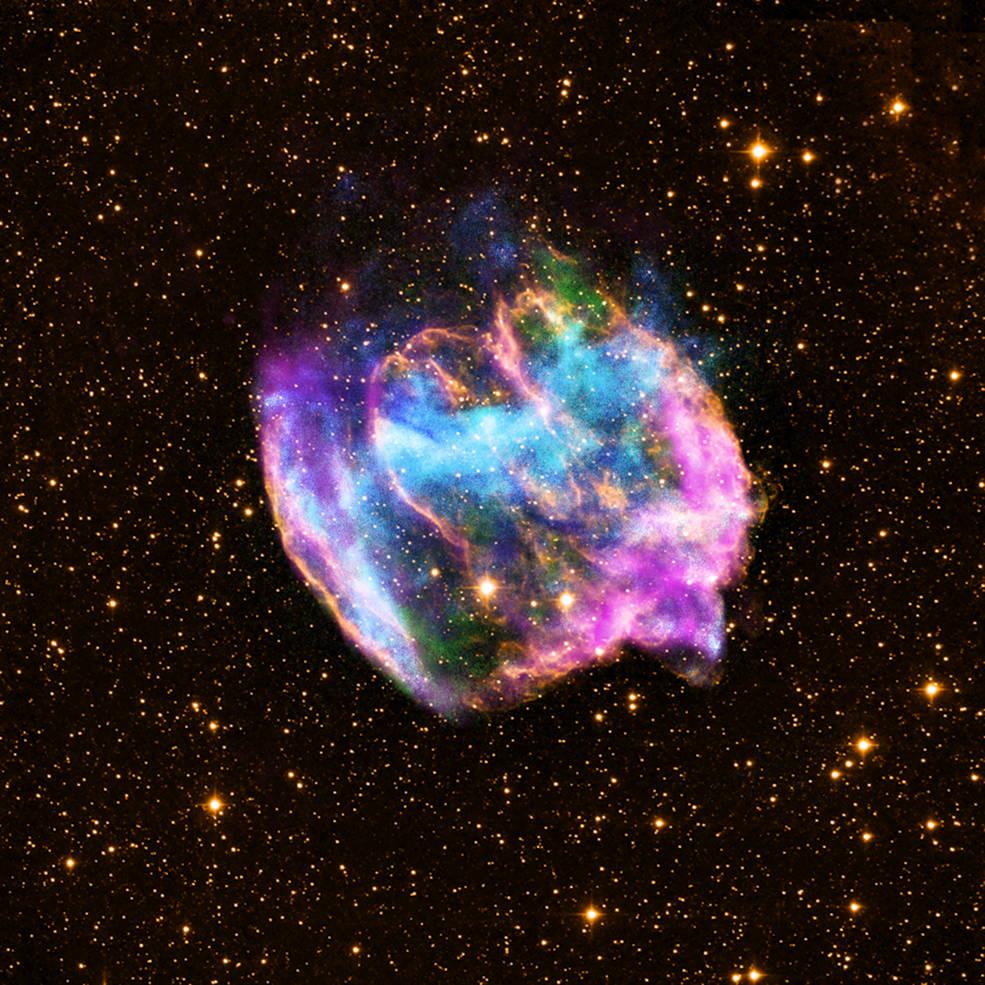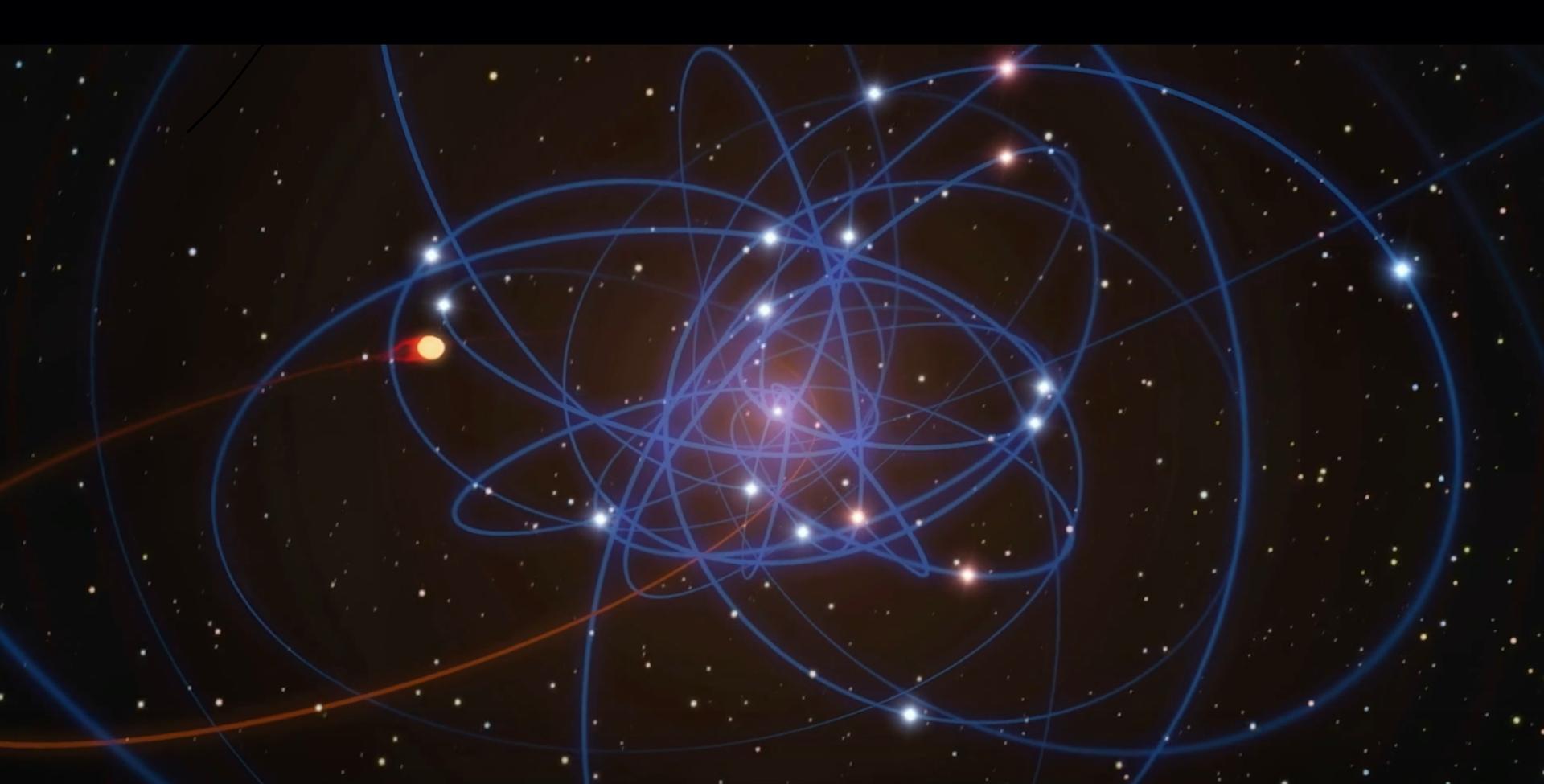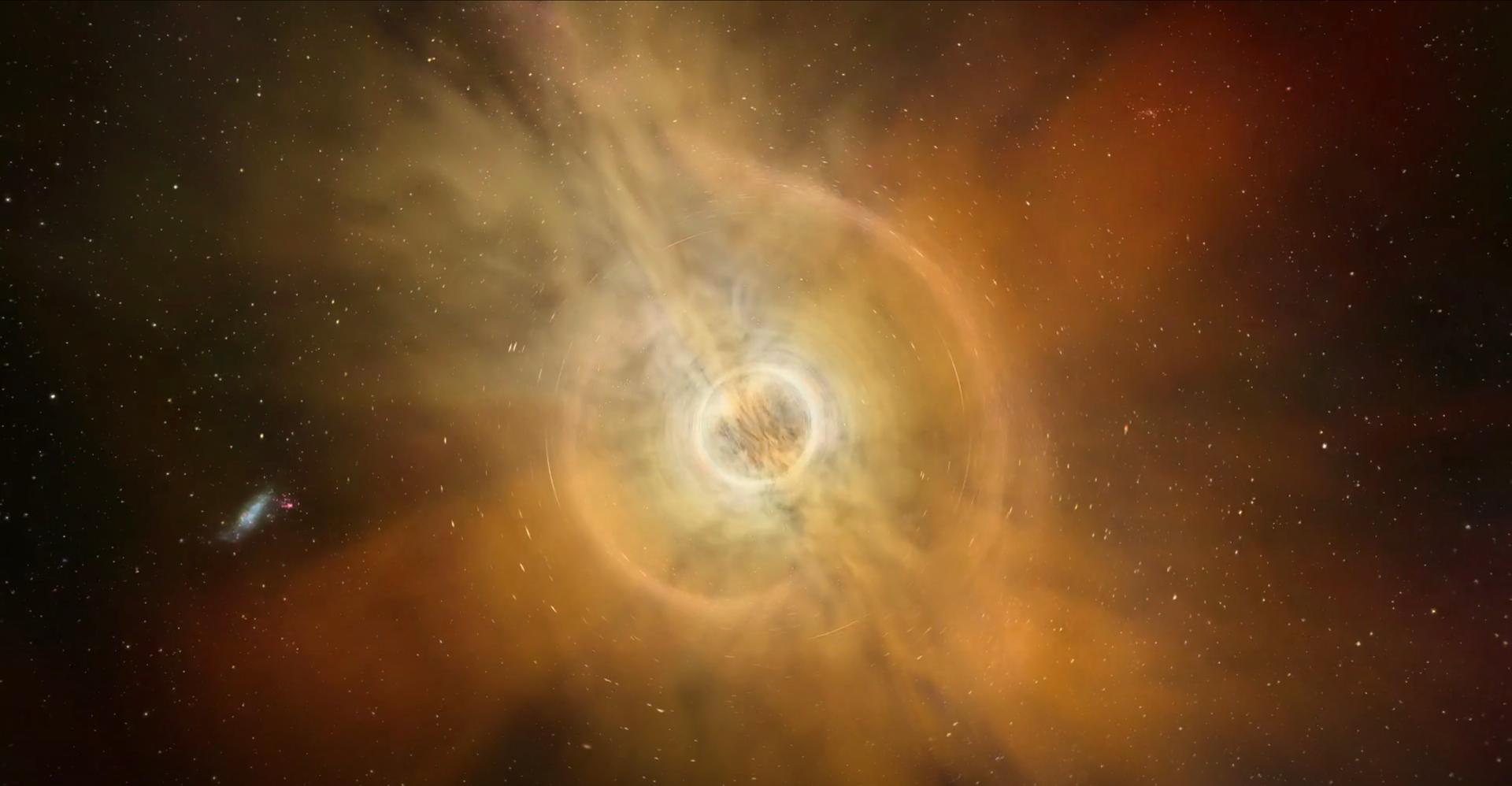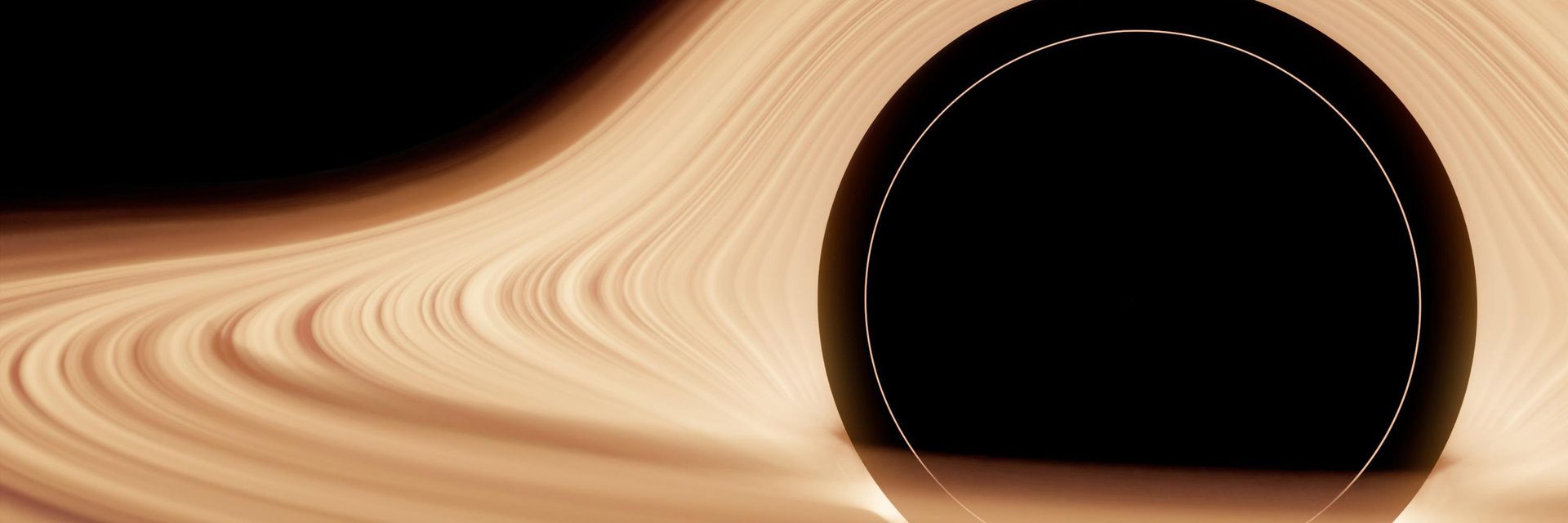Einstein himself had trouble believing that black holes could exist even though they flowed directly from his new theory of gravity. Thankfully, you don’t have to be a world-class physicist to decode some of the groundbreaking physics underlying this astronomical aberration. Our writer recounts his own experiences grappling with time travel, infinitely dense singularities, and other bizarre properties essential to black holes. With excursions into sci-fi film and fiction, he shows that you, too, can come to terms with this beautiful abstraction.
◊
I once took an astronomy class that taught me everything I ever cared to know about star formation, telescopes, and the dizzying idea of an expanding universe. The subject of black holes, though, never came up. At the time, they were still a theoretical oddity. Then in the late 1980s, Stephen Hawking wrote his classic A Brief History of Time, a book that tried to explain black holes to the masses. Many of us, myself included, started to read this slim volume and then promptly put it aside.
But, to the surprise of scientists, the idea of black holes suddenly captivated the public and became a permanent part of our popular culture. They also took on minor roles in science fiction movies until finally, with Interstellar, the strange physics of black holes, particularly their time-travel powers, drove the plot while befuddling audiences.
If my own journey in trying to decode astrophysics can serve as a model, I believe we can become less befuddled and begin to grasp this astronomical anomaly, the final result of a massive star going supernova. To paraphrase a great 20th-century physicist who was struggling with equally complex ideas, “You don’t so much understand black holes, you just get used to them.” And that’s how I came to a compromise with the heavy-weight physics underlying this other-worldly thing. I’ve accepted that some of it will always be beyond me, and the rest I simply became comfortable with.
Getting there involved first coming to terms with the obscure origins of black hole theory. In 1915, the German physicist Karl Schwarzschild discovered that a black hole was a possible solution to Einstein’s recently published equations for general relativity. Schwarzschild’s work was dismissed as a theoretical peculiarity, and, surprisingly, Einstein himself was not interested in pursuing black holes and other wilder consequences of his theory of gravity.
Over the decades, many famous physicists continued to work on the underpinnings of Schwarzschild’s analysis. They proved that it was possible for a dying star to fall into itself, forming an infinitely dense singularity. Astrophysicists have also gained insights into the hole’s mysterious border, a spherical surface better known as the event horizon, beyond which nothing, not even light itself, can escape. And while scientists know much about the event horizon, to this day no one completely understands what is happening at the singularity.
"The best that most of us can hope to achieve in physics is simply to misunderstand at a deeper level." —Wolfgang Pauli
Black Holes: Metaphor and Meaning
Black holes were once referred to by the less catchy and more descriptive name of “frozen stars.” They are indeed stars that stopped shining when their fusion reactions shut down. As gravity takes hold and forces a sudden collapse, the star’s exterior is violently flung out as it supernovas. What’s left is a cold dense core, or if the star was massive enough, the spooky black hole singularity.
Holes are certainly more evocative and suggest a kind of portal or connection to something beyond. This vague metaphor was enough for me (and I think the rest of the non-scientific public) to begin to conceptualize this bizarre thing. However, you can’t really grok black holes unless you have some way of understanding and analogizing, gulp, Einstein’s view of gravity as “curved space-time.”

W49B is the remnant of a supernova that’s thought to have a black hole at its center.
(Image Credit: NASA)
Einstein tells us that, in general, time slows down or dilates near massive celestial objects. With black holes, this effect becomes even more extreme. As explored in movies such as Interstellar, astronauts magically journey into the future as they get closer to the event horizon. A few hours for the astronauts on one planet turns into years later on the nearby spaceship that’s further from the horizon.
Black holes are the mythical time machines of science fiction made real. When H.G. Wells kicked off the genre with his classic sci-fi novella The Time Machine, he could not have known how close he was to getting the science of Einstein almost right.
Wells’s Space and Time
Published in 1898, Wells’s story begins with the man referred to only as the Time Traveller telling us that “there are really four dimensions, three which we call the three planes of Space, and a fourth, Time.” Wells was echoing the ideas of a popular lecturer, the astronomer Simon Newcombe, who was the Stephen Hawking of his day. The narrator even mentions Newcombe by name, giving the story just enough scientific underpinnings for the reader to believe in the plot.
However, we are then taken on a wild ride as the Traveller drives into the future and back as if time were a superhighway and his machine the family SUV. In Wells’s yarn, time is another dimension that’s made a little too similar to our familiar three dimensions. In reality, time is different, and it was Einstein who showed the subtle ways they were all connected to each other. However, Wells deserves kudos for popularizing time travel, and making us comfortable with the new physics soon to come.
“There is no difference between time and any of the three dimensions of space except that our consciousness moves along it. But some foolish people have got hold of the wrong side of that idea. You have all heard what they have to say about this Fourth Dimension?” —H.G. Wells, The Time Machine
Borges’s Infinite Singularity
Once past the front door of the event horizon, physicists tell us it’s impossible for anything – dust, gas, your spaceship, or light itself – to then leave. In this alternate reality, all objects hurtle inevitably toward the singularity at the hole’s center, an infinitely dense point – whatever that means – that traps everything. And once again, fiction can at least help us get used to an unknowable abstraction.
In a short story, The Aleph by Argentinian writer Jorge Luis Borges, just such an idea makes an appearance. Aleph is the first letter of the Hebrew alphabet and, intriguingly, the symbol also given by mathematician Georg Cantor to represent different types of infinities.
In the Borges story, the Aleph is a teeny shimmering orb, located, of all places, in the basement of a Buenos Aires house, in which everything can be seen by an observer, who in the story is Borges. He sees in the Aleph the totality of life on Earth, as well as Borges himself gazing into the Aleph, and the Aleph itself in an infinite reflection of infinities.
At this point, the reader, myself included, is left with the feeling that the best we can do is to get a brief glimpse at infinite things – mass, time, and perhaps Borges’s own Library of Babel – but these things will always remain beyond us.
Tips for Living in Einstein’s Space-Time
Over the years, with no set plan, I tried to achieve my own brief glimpse. After losing my battle with Hawking’s Brief History of Time, I continued for unknown reasons to read popular science articles on the latest astronomical discoveries, went to a few museum exhibits during Einstein’s centennial year in 2015, and attended the occasional lectures given by learned astrophysicists. I was hooked.
At some point, I began to make out more of the details, becoming comfortable with the idea that space and time are deeply interrelated. I discovered that it’s more than a mere mathematical contrivance: space-time really has an independent existence. As I sit here writing and not moving in space, I’m hurtling through the time part of space-time, and it’s just as valid a journey as getting into my car and driving to the supermarket.

Computer simulation of stars orbiting the black hole Sagittarius A at the center of our Milky Way Galaxy
In Interstellar, an important but confusing plot device is that time slows down on the planet closest to Gargantua, the name given to the movie’s photogenic black hole, compared to the spaceship that’s further away in orbit. One hour on the planet’s surface worked out to a mindblowing seven years into the future on the ship. This is all in accordance with Schwarzschild’s space-time solutions for black holes.
Amazingly, Schwarzschild’s equations also describe space-time on Earth’s surface. And you might reasonably ask if there’s a weakened version of the time dilation effect in Interstellar happening here as well. And the answer is an emphatic yes.
Over the years, several important experiments have been conducted to validate that gravity does indeed slow down the passage of time. The tests have all confirmed Einstein’s theories to ever higher-levels of precision. Clocks on the ground – where gravitational time dilation is stronger – run ever so slightly slower than clocks in the Earth’s orbit. Another way of saying this is that we age more slowly at lower compared to higher altitudes!
The Shimmering Orb of the Black Hole
If our Sun were to supernova and become a singularity, Schwarzschild’s equations tell us that the event horizon would be a mere 5.6 kilometers in diameter – about 3 miles. And in case you’re curious, if our home world were somehow compressed into a point, its black hole diameter works out to just a smidge over a half-inch.
Both of these are teeny compared to the massive black hole known as Sagittarius A at the center of our galaxy. Its mass is thought to be about 4.5 million times our Sun, and the event horizon is the same proportion larger at a gaping 12 million kilometers.
MagellanTV’s The Most Powerful Black Holes in the Universe tells the fascinating story of the decades-long hunt of the Sagittarius black hole. This scientific investigation earned the project’s leaders, Reinhard Genzel and Andrea Ghez, the Nobel Prize in 2020.
Beyond the dry equations, all of us can appreciate some of the strangely beautiful imagery that physicists tell us occurs outside the event horizon. Furthest away from the hole, accretion disks containing gas and stellar debris can be found. These disks swirl around the horizon at incredible speeds, generating heat and powerful X-rays. The energy produced can be detected by radio astronomers and has provided evidence for the underlying singularity’s existence.
And then, a little closer to the horizon, a photon sphere can arise as light itself is captured and magically goes into orbit around the hole.
Eventually both debris and orbiting light spiral into the event horizon and vanish into the singularity. There is a wonderful computer-generated graphic in the aforementioned documentary showing all these various orbits. And you can gaze upon the shimmering Aleph that forms below:

Black Holes: Beautiful and Unknowable
As soon as I began to understand more about black holes, I realized I understood nothing. Closer to the event horizon, space itself is being contracted or crushed. And beyond the event horizon, physicists say that time stops and space flows like a waterfall toward the singularity at speeds greater than that of light. It’s an effect that was beautifully rendered in Interstellar. Ultimately, powerful tidal forces due to increasingly sharper space-time curvature pull apart everything in a process informally known as “spaghettification.”
Coldy beautiful. After my own black hole journey to try to grasp these ideas, I’m satisfied now to sip a cup of tea, marvel at the black hole simulations, and ponder just a little on what it means.
By the way, Borges says in his story that the Aleph is about an inch in diameter, very close to what was calculated above based on the Schwarzschild radius of the Earth. Borges, as always, was light years ahead of us.
Ω
Title image: Black Hole by user AlexAntropov86 via Pixabay.

